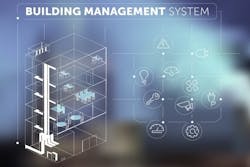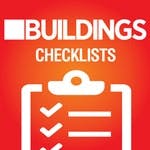Building controls are more affordable than ever, but many older buildings still don’t have simple technologies like these to make managing the facility easier. Is it time to upgrade your legacy building with a control suite?
Types of Building Controls
Lighting and HVAC are two of the most popular building systems for control implementation, explains Dalton Ling, director of operations and development for Energy Source. “The technologies to control these systems are tried and proven and have been around for years, so people are generally familiar with it and the financial impact is well known,” he says.
Building systems where controls have made less of an impact could still save you money, however. Consider the potential impact from retrofitted controls in other areas, including:
Security
Door alarms are popular, but they’re not the only security control option. Control hardware that can tell you whether your door is locked or if someone has left it open can help you find gaps in your security and ensure the whole facility is locked up when it’s unoccupied.
BUILDINGS Checklist
Building Security Assessment
Start with these basic steps and common security gaps. Move on to upgrades, advanced technologies and other investments as your individual situation warrants. Gain access to yours now >>
Business Intelligence
Simple sensors at your entrance can count the number of people who come through your door. This can be especially useful for applications like retail. People-counting sensors can also gather valuable security information if you use badges or other scannable credentials.
Check to see whether the number of people entering an area matches the number of people who scanned their credentials—if not, someone is tailgating or piggybacking.
BUILDINGS Podcast
Security Threats of Tailgating in Your Facility
[podcast]
Sean Ahrens, a leader in the field of security and resilience, as well as a project manager for Affiliated Engineers, Inc., shares insights into the security threats of tailgating in respect to the access control of your building. Listen now >>
Leak Detection
Air conditioning equipment and other leak-prone areas, such as windows and basements, can benefit from moisture-detecting sensors. Connect the sensors to a control suite that will alert you when moisture is detected.
Can Building Controls Save You Money?
There are a few ways to determine whether installing new controls will reduce your operating expenses. Ling suggests starting with your existing expenses and determining which building system is consuming the most resources. If you’re not sure, consider using data loggers to track the consumption of individual motors or pieces of equipment.
“If a system is one of the biggest ticket items, maintenance-wise or operationally, chances are it’s low-hanging fruit,” Ling says. “I would start there. Say the HVAC system is 40 percent of your operating expenses—if you can cut that back by 20 percent [with controls], it’s pretty impactful.”
[Related: A Case for Future-Proofed Indoor Location Services]
Controls also allow you to automate data collection you’d otherwise have to do manually, says Bryce Keeney, chief technology officer for Teguar, a manufacturer of panel and box PCs that can interact with building controls. Make sure your savings estimates reflect the value of saved time.
Include any existing controls in your assessment too, Ling suggests. A control suite installed 10 or more years ago can likely become more efficient.
How to Avoid Pitfalls
Building controls are meant to make your job easier, but mistakes during installation, commission or operation can wipe out the savings you were expecting.
Don’t make assumptions.
“Often it’s really just a misunderstanding or mis-specification of the space and what a customer is looking for,” Ling says. “The biggest mistakes I see are when assumptions are made with sensors without doing your due diligence on the type of sensor or the spread. Ultimately, it comes down to the specification and the design you’re going with. That’s where a lot of issues can be avoided.”
Set expectations from the start.
Setting expectations at the beginning of your project is the key to success, Ling says. “Not everybody needs to see live energy usage or asset tracking,” he adds. “They might just need something that’s as simple as scheduling at the push of a button or adjustable occupancy sensors, but sometimes that gets lost in translation or isn’t conveyed between the customer and the contractor or controls company.”
Communicate your needs clearly with your provider.
Communicating your expectations with your provider also includes making them aware of your needs, Keeney says. For example, when you’re specifying panel PCs to communicate with your sensors, get them up-to-date with your needs upfront so that you’re not wasting time looking at solutions that won’t work.
“The place to start is understanding the input-outputs that you need to communicate with your sensors,” explains Keeney. Most sensors take one of three types of input-outputs (IOs): USB, serial ports or the LAN or ethernet style ports you usually see on an ethernet cord.
“It’s important to know what are the interfaces you need for deployment and what number of them. If you don’t tell the hardware provider ‘I need eight USB ports,’ we might be talking to you about solutions where it’s not possible to get that number of IOs,” he explains.
Let your provider know the environment of your controls.
Familiarize your provider with the environment your controls will be in as well, Keeney urges.
[LEED Zero: 4 Ways to Add Net Zero to Your LEED Certification]
“How rugged of an environment is it? Will it get wet? Will it get really hot or really cold? If it’s going to be in an environment that’s going below freezing or above 100 degrees, we suggest hardware that’s designed to handle those types of environments. Is it a high-vibration environment or is it going in an air duct that will be dusty? Just explaining the environment it’s going to be in would be a good summary,” he says.
Choose a provider who will train your team correctly.
Make sure you go with a provider who will thoroughly train your team on operating the new control system, Ling says. “References are huge. Ask about their training procedure or policy. See if there’s a webinar or a site or a past customer you could ask for feedback,” Ling adds.
“I would also push for a service plan. It’s not a bad idea, because you’re able to get a refresher on the system every 12 to 18 months and keep everybody up to date,” says Ling.
This training is crucial—you don’t want to get stuck with a control system that has a steep learning curve. Getting the whole team on the same page from the beginning will allow your department to do what it does best—operating buildings efficiently.
Two handpicked articles to read next:
About the Author
Janelle Penny
Editor-in-Chief at BUILDINGS
Janelle Penny has been with BUILDINGS since 2010. She is a two-time FOLIO: Eddie award winner who aims to deliver practical, actionable content for building owners and facilities professionals.


